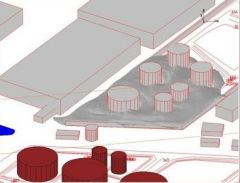INFORMATION
How to identify contaminated area with NH3 gas and how to
address critical situation, in case of a huge amount of NH3 gas leak?
Our Solution: Real Time Dispersion Simulation
[Back grounds]
Your site has already installed gas monitoring system which covers indoor and
outdoor area in case when toxic/flammable gases leak will be occurred.
The key device of detecting toxic/flammable gases are sensors. Most parts of
your drills might be mentioned the countermeasures on how to prevent from
accidents.
[Reguratory Status in Thailand]
Department of Industrial Works, The Ministry of Industry is considering
issuing a ministerial regulation that will mandate factories to acquire an
insurance covering 3rd party protection against various accidents.
January 30, 2014 by Thai Financia Post,
[Detecting Devices]
You know that there’re so many kinds of sensors developed such as;
l Metal Oxide Based Gas Sensors,
l Capacitance Based Gas Sensors
l Acoustic Wave Based Gas Sensors
l Calorimetric Gas Sensors
l Optical gas sensors
l Electrochemical gas sensors
Some detectors are damaged when high concentration dose will be induced to
the detectors. Take example for Ammonia [1], typical electrochemical
ammonia detector will be able to detect only up to 100 - 300 ppm.
Photoionization detector (PID) might be a solution to solve this problem.
[1] NIOSH Pocket guide to Chemical Hazards [http://www.cdc.gov/niosh/npg/]
Time Weighted Average: 25ppm
Short term Exposure Limit: 35ppm
Immediate Danger to life and Health: 300ppm
Lower Explosive Limit: 15% (150,000ppm)
[Explosion in the United States]

Fig. NH3 Release caused Catastrophic Vessel Failure and Death
at D.D. Williamson&Co., KENTUCKY, USA 2003
[http://www.csb.gov/d-d-williamson-and-co-catastrophic-vessel-failure/]
[Identify Affected Area in Your Site After Accidents]
How to identify contaminated area with NH3 gas and how to address critical
situation, in case of a huge amount of NH3 gas leak in concentration of above
300 ppm at your site, according to your emergency drills?
[Our Solution]
We propose to use Real Time Dispersion Simulation Method in identifying
critical area in your site. Please visit the web site at;
[http://www.fluidyn.com/fluidyn/accident-risk-consequences/real-time-impact-prediction]
Please contact with;
Hashimoto, Mobile:+66(0) 91 545 4896, shinya_h@hstecheng.com
fern, Mobile :+66(0)92 223 7536, sasiton_t@hstecheng.com (Technology Specialist)
Bee, Mobile : +66(0)91 557 9303,sunisa_t@hstecheng.com (Account & Marketing Representative)
RISK COMMUNICATION SEMINAR for INDUSTRIAL CHEMICALS was held on June 20th at Interchage 21 Buiding, Bangkok

Risk communication was a key item for Pollutant Release/ Transfer and Register (PRTR) system and it is a good chance for pollutant generators to review their production lines drastically to reduce input materials and to reduce pollutants from the end of pipes.
PRTR initiatives will be a chance to accelrate competitiveness of Thai industries.

HS-TECH ENGINEERING would like to take a role as a Thai local provider
not only for EHS (Environment, Health and Safety) burden mitigation
solution but also for explosion/fire evaluation methods as well as
productivity enhancement solution provider in keeping strong relationships
with various sectors.
Please contact with;
Hashimoto, Mobile:+66(0) 91 545 4896, shinya_h@hstecheng.com
fern, Mobile :+66(0)92 223 7536, sasiton_t@hstecheng.com (Technology Specialist)
Bee, Mobile : +66(0)91 557 9303,sunisa_t@hstecheng.com (Account & Marketing Representative)
A gas (sulphur dioxide, SO2 etc.) leak and explosion caused fire from IRPC, Rayong Thailand at around 18:00 in June 9th 2014.
Fire broken out at IRPC's combined gas and oil plant.
http://www.youtube.com/watch?v=e2d7Xg5hyFc
HS-TECH ENGINEERING is able to evaluate explosion/fire and leakage risks, caused by petro-chemical industries, using 3D software 'fluidyn-ASSESS-RISK [1] ' in collaboration with fluidyn.
You might cut down on damage insurance fee drastically by evaluating risks with fluidyn-ASSEE RISK software.


NOTE: Figures were prepared by fluidyn Co., France
Please contact with :
Hashimoto (Mr.), shinya_h@hstecheng.com or +66(0)91 545 4896 (English/Japanese)
Bee (Ms.), sunisa_t@hstecheng.com (Thai)
[1]
fluidyn-ASSESS-RISK is a software tool for the analysis of accident scenarios on industrial sites. The software uses the latest UFIP(French Union of Petroleum Industries) risk assessment methodology (Blue Book) for petrochemical refineries to analyse all possible accidental scenarios on petrochemical sites by analytical and empirical methods. This UFIP methodology has been validated by INERIS (French National Institute for Environment and Risks).
fluidyn-ASSESS-RISK is a software developed by TRANSOFT International in collaboration with the UFIP (French Union of Petroleum Industries), a major organisation of French petroleum industry.
Useful web site
http://af.reuters.com/article/commoditiesNews/idAFL4N0OQ37A20140609
http://www.nationmultimedia.com/national/Blaze-at-IRPC-under-control-30235867.html
New approach in tracing pollutant sources
We’re providing services to evaluate pollutant gas or particle dispersion from various sources. You can see SO2 dispersion graphically from stacks
in Thailand.


On the other hand, some governments in Asian country which face critical air pollution are using 3D simulation software to find out sources of pollutant generation.
Don’t you think it’s an EYE OPENER?
There are some key factors for installation of Pollutant Release, Transfer Register (PRTR) System such as;
a) Develop methods on how to share information with various stakeholders regarding quantity of chemicals to the environment by enterprise who discharge chemicals.
b) Develop methods on how to calculate amount of pollutants from various media such as: end of pipes (stacks, etc.) in a simple way.
c) Enhance voluntary activities by enterprises themselves to mitigate environment, safety and health concerns through this PRTR System Integration.
It will also be a good chance to review manufacturing lines to reduce input materials and cost cutting for your products with all players, indicated below.
You know complaints from QA/QC people: why do you want to review manufacturing line which are in stable good condition?
Please click on the thumbnail to download players, involved.


